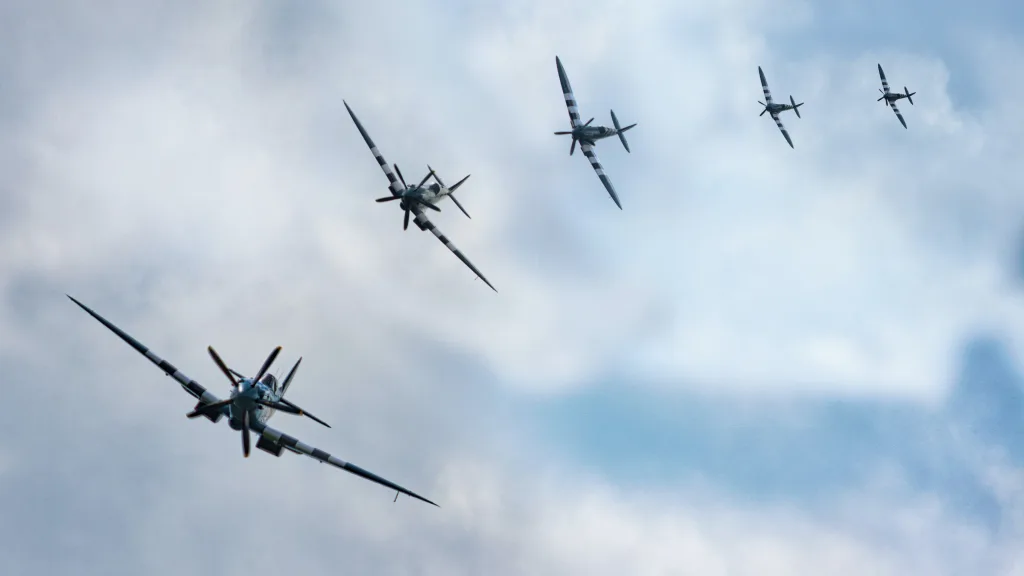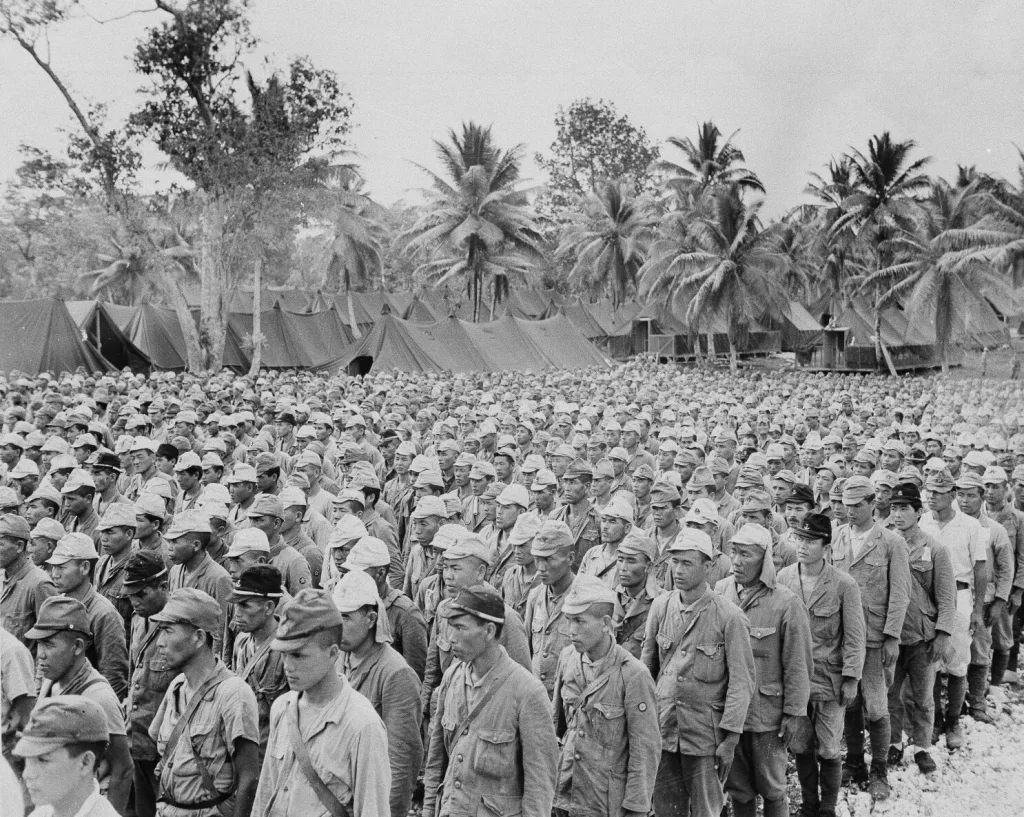Island hopping, a military strategy employed by the United States during World War II, played a crucial role in the Pacific theater. This tactic involved capturing key islands and atolls, equipping them with airstrips, and bringing B-29 bombers within range of the enemy homeland. By bypassing strongly defended islands and cutting off supply lanes, the Americans effectively isolated and weakened Japanese bases. Island hopping not only provided footholds across the Pacific but also proved instrumental in the eventual defeat of Japan.
The concept of island hopping emerged as a response to the challenges posed by the vast expanse of the Pacific Ocean. Rather than engaging in direct assaults on every Japanese-held island, the United States strategically selected certain islands for capture. These islands were chosen based on their strategic significance, such as their proximity to Japan or their potential as airbase locations.
The initial amphibious landings of island hopping allowed Allied forces to gain control of the areas surrounding the bypassed Japanese bases. This enabled them to establish defensive positions and deny the enemy access to crucial resources. By cutting off supply lines, the Americans effectively isolated the Japanese forces on these islands, leaving them to wither without reinforcements or provisions.
One of the key objectives of island hopping was to bring B-29 bombers within striking distance of Japan. These long-range bombers were capable of inflicting significant damage on the enemy homeland. By capturing islands and equipping them with airstrips, the Americans created forward bases from which they could launch devastating aerial attacks on Japanese cities and military installations.
Island hopping also had the advantage of conserving military resources. Rather than expending significant manpower and equipment on capturing heavily fortified islands, the Americans focused on securing smaller, strategically important islands. This allowed them to conserve their forces for future operations and avoid unnecessary casualties.
The result of island hopping was the gradual encirclement and isolation of Japanese-held territories. As the Americans advanced through the Pacific, they steadily cut off supply routes and weakened the Japanese forces. The strategy put increasing pressure on Japan, both militarily and psychologically, as their territories were gradually reduced and their ability to mount effective resistance diminished.
Island hopping was a crucial strategy employed by the United States during World War II in the Pacific theater. By selectively capturing key islands, equipping them with airstrips, and bypassing heavily defended areas, the Americans effectively isolated and weakened Japanese forces. This strategy not only provided the US with crucial footholds across the Pacific but also paved the way for the eventual defeat of Japan.
What Was The Result Of The Island Hopping Strategy?
The result of the island hopping strategy, employed by the Americans during World War II, was the successful cutting off of supply lines to the “skipped” islands that had not been directly attacked. This tactic allowed the U.S. forces to isolate and weaken Japanese-held islands, making it difficult for the Japanese to maintain control over these areas. As a result, the Americans were able to conquer these islands without expending excessive military force. The island hopping strategy effectively disrupted Japanese supply routes and weakened their hold on the Pacific islands, gradually pushing them back towards their home islands. This strategy played a crucial role in the eventual Allied victory in the Pacific theater of the war.

What Was The Concept Of Island Hopping?
The concept of island hopping was a strategic military tactic employed by the United States during World War II in the Pacific theater. The goal was to gradually advance towards the enemy homeland by selectively capturing and establishing footholds on key islands and atolls in the Pacific Ocean.
The strategy involved identifying and targeting islands that were strategically located and had potential for the construction of airstrips. These airstrips would then enable the deployment of B-29 bombers, which could reach and bomb the enemy homeland. By doing so, the US aimed to weaken the enemy’s defenses and disrupt their supply lines.
Instead of directly attacking heavily fortified and defended islands, the island hopping strategy involved bypassing these strongholds and moving on to capture less fortified islands. This approach helped to conserve resources and minimize casualties, as assaulting heavily defended islands head-on would have been more costly and time-consuming.
By capturing and establishing control over these less fortified islands, the US effectively cut off enemy supply lanes and isolated the remaining strongholds. This isolation weakened the enemy’s ability to receive reinforcements, supplies, and support, leading to a gradual deterioration of their defenses.
The island hopping strategy was a crucial part of the US military’s overall plan to gradually advance towards Japan. It allowed for a more efficient and strategic approach to neutralizing enemy forces in the Pacific, while also providing a stepping stone to bring the war closer to the enemy homeland.
The concept of island hopping involved selectively capturing key islands and atolls, equipping them with airstrips, and bypassing heavily defended islands. This strategy allowed the US to bring bombers within range of the enemy homeland, cut off supply lanes, and gradually weaken the Japanese defenses in the Pacific theater of World War II.
Why Was Island Hopping Important In Ww2?
Island hopping played a crucial role in World War II due to its strategic significance in the Pacific Theater. The Allied forces, primarily led by the United States, employed this military tactic to gradually advance towards Japan by capturing key islands along the way.
There are several reasons why island hopping was important in WWII:
1. Breaking the Japanese defensive perimeter: The Japanese had established a strong defensive perimeter in the Pacific, known as the Greater East Asia Co-Prosperity Sphere. By bypassing heavily fortified Japanese-held islands and capturing strategically important ones, the Allies effectively broke through this defensive line.
2. Cutting off Japanese supply lines: By capturing and controlling islands, the Allies were able to sever Japanese supply lines and disrupt their ability to resupply or reinforce their bases. This significantly weakened the Japanese forces and hindered their ability to sustain their military operations.
3. Establishing forward bases: Island hopping allowed the Allies to establish forward bases closer to Japan. These bases provided essential logistical support for further operations, such as refueling, repairing damaged ships, and launching air raids on Japanese-held territories.
4. Gaining air superiority: The capture of key islands in the Pacific enabled the Allies to construct airfields and deploy fighter planes, which ensured air superiority over the region. This air superiority was crucial in supporting subsequent operations, protecting the sea routes, and conducting aerial attacks on Japanese targets.
5. Psychological impact: Island hopping had a significant psychological impact on both the Japanese and Allied forces. For the Japanese, losing control of previously secure islands shattered their perceived invincibility and boosted Allied morale. For the Allies, each successful capture of an island boosted their confidence and determination to push further towards Japan.
Island hopping was important in World War II as it allowed the Allies to gradually advance towards Japan, cut off Japanese supply lines, establish forward bases, gain air superiority, and have a psychological impact on both sides. This strategy ultimately paved the way for the eventual defeat of Japan in the Pacific.
Why Was Island Hopping Used?
Island hopping was used by the United States as a strategic military plan during World War II to defeat Japan. The main objective of this approach was to gain control over key islands in the Pacific Ocean, which would serve as stepping stones for further advancement towards Japan. The following reasons highlight why island hopping was used:
1. Military Bases: By capturing and establishing military bases on various small islands, the United States aimed to create forward positions for their forces. These bases provided essential facilities and infrastructure, including airstrips and ports, which enabled the U.S. to launch air attacks, resupply their troops, and project their military power in the region.
2. Strategic Advantage: Island hopping allowed the U.S. to bypass heavily fortified Japanese-held islands and focus on capturing less-defended islands that were strategically positioned. This approach helped to minimize casualties and conserve resources, as attacking heavily fortified islands directly would have been much more challenging and costly.
3. Control of Sea and Air Routes: Gaining control over islands enabled the U.S. to secure important sea and air routes in the Pacific. This not only facilitated the movement of troops, equipment, and supplies but also restricted Japan’s ability to reinforce their positions or launch counteroffensives.
4. Isolation of Japanese Forces: By capturing and securing islands, the U.S. aimed to isolate Japanese forces, making it difficult for them to receive reinforcements or supplies. This strategy weakened Japan’s hold on the region and allowed the U.S. to gradually encroach upon Japanese territory.
5. Psychological Impact: Island hopping had a significant psychological impact on both the Japanese and American forces. For the Japanese, the continual loss of previously unchallenged territory eroded their morale and weakened their resolve. On the other hand, the capture of each island boosted American morale and demonstrated progress towards the ultimate goal of defeating Japan.
Island hopping was used as a military strategy to gain control over key islands in the Pacific, establish military bases, secure sea and air routes, isolate Japanese forces, and psychologically weaken the enemy. This approach allowed the United States to effectively advance towards Japan while minimizing casualties and conserving resources.

Conclusion
Island Hopping was a strategic military tactic employed by the United States during World War II in the Pacific theater. The objective of this strategy was to gain control of key islands and atolls in the Pacific, while bypassing strongly defended Japanese bases. By capturing and equipping these islands with airstrips, the U.S. was able to bring B-29 bombers within range of the enemy homeland, effectively cutting off supply lines and isolating the remaining Japanese forces.
The Island Hopping strategy proved to be highly effective in weakening the Japanese forces and ultimately leading to their defeat. By skipping over heavily fortified islands and focusing on capturing strategic locations, the Americans were able to conserve military resources and minimize casualties. This tactic also allowed them to establish a network of military bases across the Pacific, which served as launching points for further offensives.
Additionally, Island Hopping played a crucial role in isolating and neutralizing Japanese bases. By cutting off their resupply and rescue routes, the U.S. forces gradually weakened the Japanese hold on these islands, making it difficult for them to sustain their positions. This approach not only prevented the enemy from regrouping and reinforcing their defenses but also facilitated the eventual conquest of these bypassed islands without the need for extensive military force.
Island Hopping was a strategic and successful military maneuver that contributed significantly to the Allied victory in the Pacific during World War II. By seizing control of key islands and cutting off Japanese supply lines, the United States was able to establish a strong foothold in the region and gradually push towards the enemy homeland. This tactic demonstrated the importance of strategic planning and adaptability in achieving military objectives, while also minimizing casualties and conserving resources.
